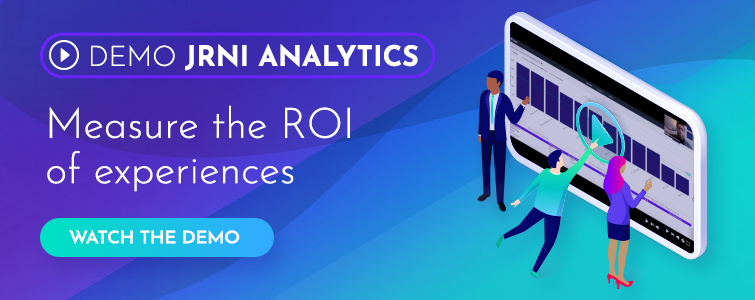If you’ve been reviewing your analytics data, then you know just how powerful your data is and how it can help you improve the customer experience. But it isn’t always easy to measure success, especially when you need to tie your experiential relationship management (XRM) strategy to overall business objectives. That’s why it’s imperative to set up key performance indicators (KPIs) for your experiences in 2021 if you want to track performance and continuously evaluate your progress toward meeting goals.
Setting up KPIs will help your team measure what truly matters - and ensure you can accurately measure success. So let’s take a look at how you and your team can identify your XRM KPIs.
Identifying your XRM KPIs
It’s likely you offer many types of experiences for your customers, especially given the virtual world we’ve been living in during the pandemic. From remote appointments and consultations to online events, it’s important to identify all of the ways you engage with your customers, so that you can evaluate the success of each experience and how they fit into your overall business strategy. So what experience-related KPIs are vital for your business?
What are KPIs?
First, let’s define what KPIs are and what key components make up a KPI. KPIs are a group of metrics that help you measure progress in meeting specific strategic goals. Putting together great KPIs and ensuring that they work well for your business is crucial because they will give you a pulse on how well your experiences are working for your organization.
There are four key parts in creating an effective KPI, including:
- Measure: What are you measuring specifically? In this case, the more specific, the better! For example, maybe your team wants to increase appointment bookings by a certain percentage next year.
- Target: What is the numerical value associated with what you're measuring and by what date do you want to achieve this? So, again, if you are looking to increase appointment bookings by a percentage, your target might be a 10% increase by the end of next year.
- Source: Where are you pulling your data from? For appointment bookings, this data can be pulled from your XRM analytics. This data should be your single source of truth when measuring your progress.
- Frequency: This is how often you’re pulling your data and updating performance. Is it daily, weekly, monthly, quarterly? This can depend on what your team has time to manage (and if you have the right analytics tool in place to help automate reports/dashboards), but you should aim to check on your KPIs as often as possible - at least monthly!

What XRM KPIs should we track?
Knowing what XRM KPIs to track depends on what types of experiences you offer, and of course, your organization’s specific goals. They should be tied to strategic objectives and should give you insight into the health of your business. Here are some XRM KPIs that you should consider:
- Outcomes: To truly understand the ROI of your experiences - whether an in-store or remote appointment, an important KPI to track is outcomes. Is there a certain conversion rate you are targeting or is there a certain amount of revenue expected per experience type? What is your organization’s goal for your experiences? By tracking your appointment and event outcomes by conversion rate and revenue generated, you can track how well your experiences are doing for your bottom line.
- Year over year growth: While outcomes could be a KPI to look at for specific types of experiences, you can also track the revenue of all of your experiences. Perhaps your organization has a goal to increase revenue from customer engagements by 15%. Depending on what makes sense for your business, you could set this up as a target and then track monthly or quarterly, or you could set it up to analyze progress over the course of the year. This KPI is good to get a quick glance at your success and be able to easily compare year to year progress.
- Cancellation rates: Another great KPI is cancellation rate. Again, you could track this with a percentage - let’s say you’re trying to keep the cancellation rate of your appointments under 10%. By setting up a KPI target of 10%, your team can monitor this KPI and determine what steps you need to take if you hit or go over this target.
- No-shows: What’s worse than a cancellation? A no-show! That’s why establishing a KPI with a low percentage or low number of no-shows is also critical. Maybe you aim to have less than 5% of all appointments (both in-person and online) result in a no-show. By closely monitoring the percentage of no-shows, you can make an action plan to improve if you hit or go over your no-show target.
- Operational efficiency: Are your store and branch locations properly staffed to ensure minimal lead and wait times? Lead and wait times have a huge impact on the customer experience, so it’s crucial to set up a KPI specific to these metrics. While these metrics should be examined on a case by case basis by your team and staff members as well, having a KPI that tracks the average wait time or lead time is a good way to ensure you can make improvements over time.
How to track and measure your KPIs
Tracking KPIs is generally done through your XRM analytics and business intelligence tools. The best experience analytics tools will have an easy way for you to assess your progress through dashboards and advanced reports, as well as allow you to set up automated alerts. Aside from your regular check-in meetings, having a tool that allows for automatic notifications is a great way to give your key stakeholders a quick glance into the company’s success and progress, as well as alert them to any issues that might require immediate attention. Having well-defined and established KPIs will keep your entire team on the same page - making it easier to reach and exceed your goals!
Additionally, you should continue to evaluate what’s most important to your business over the year. Along with frequently checking your analytics and progress, you should also continuously look at your KPIs to ensure they accurately reflect your goals. Things change, so if a KPI is no longer useful, then you can tweak it or remove it. When there is so much data to analyze, you always want to ensure you are tracking what actually matters!
So there you have it - that’s how you can identify and track your XRM KPIs to ensure you are set up for success in 2021! If you want to learn more about XRM analytics and ways you can easily track your progress, then watch our on-demand webinar, “The analytics of experiences”. Additionally, if you want to learn more about JRNI Analytics, then be sure to watch the demo!




